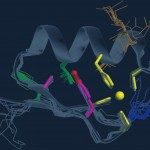Lien vers Pubmed [PMID] – 28249776
J Allergy Clin Immunol. 2017 Dec;140(6):1671-1682.e2
BACKGROUND:
Incontinentia pigmenti (IP; MIM308300) is a severe, male-lethal, X-linked, dominant genodermatosis resulting from loss-of-function mutations in the IKBKG gene encoding nuclear factor κB (NF-κB) essential modulator (NEMO; the regulatory subunit of the IκB kinase [IKK] complex). In 80% of cases of IP, the deletion of exons 4 to 10 leads to the absence of NEMO and total inhibition of NF-κB signaling. Here we describe a new IKBKG mutation responsible for IP resulting in an inactive truncated form of NEMO.
OBJECTIVES:
We sought to identify the mechanism or mechanisms by which a truncated form of the NEMO protein inhibits the NF-κB signaling pathway and leads to the IP human disease.
METHODS:
We sequenced the IKBKG gene in patients with IP and performed complementation and transactivation assays in NEMO-deficient cells. We also used immunoprecipitation assays, immunoblotting, and an in situ proximity ligation assay to characterize the truncated NEMO protein interactions with IKKα, IKKβ, TNF receptor-associated factor 6, TNF receptor-associated factor 2, receptor-interacting protein 1, Hemo-oxidized iron regulatory protein 2 ligase 1 (HOIL-1), HOIL-1-interacting protein, and SHANK-associated RH domain-interacting protein. Lastly, we assessed NEMO linear ubiquitination using immunoblotting and investigated the formation of NEMO-containing structures (using immunostaining and confocal microscopy) after cell stimulation with IL-1β.
RESULTS:
We identified a novel splice mutation in IKBKG (c.518+2T>G, resulting in an in-frame deletion: p.DelQ134_R256). The mutant NEMO lacked part of the CC1 coiled-coil and HLX2 helical domain. The p.DelQ134_R256 mutation caused inhibition of NF-κB signaling, although the truncated NEMO protein interacted with proteins involved in activation of NF-κB signaling. The IL-1β-induced formation of NEMO-containing structures was impaired in fibroblasts from patients with IP carrying the truncated NEMO form (as also observed in HOIL-1-/- cells). The truncated NEMO interaction with SHANK-associated RH domain-interacting protein was impaired in a male fetus with IP, leading to defective linear ubiquitination.
CONCLUSION:
We identified a hitherto unreported disease mechanism (defective linear ubiquitination) in patients with IP.



